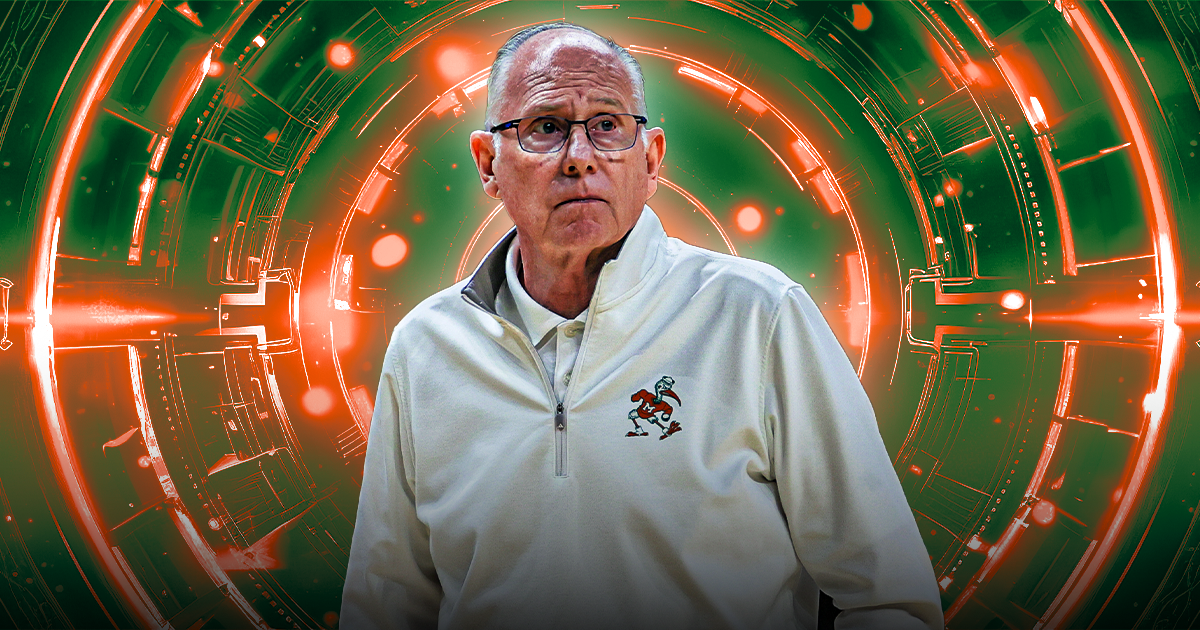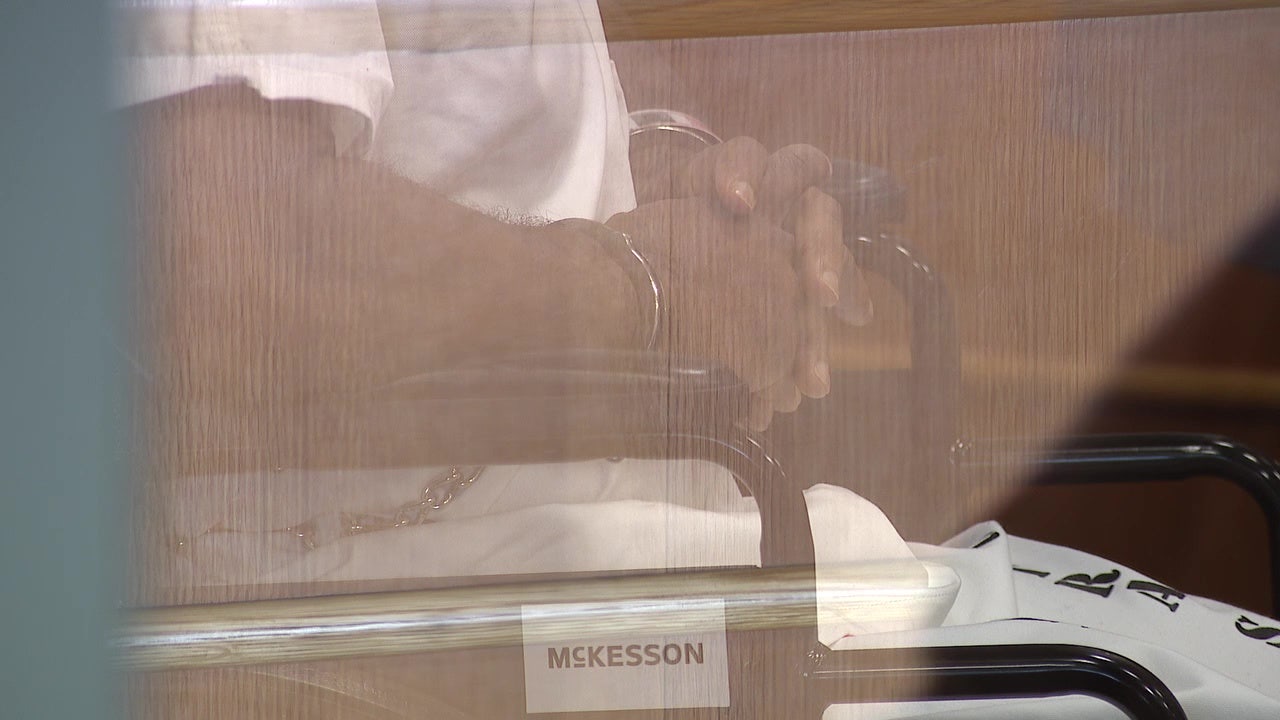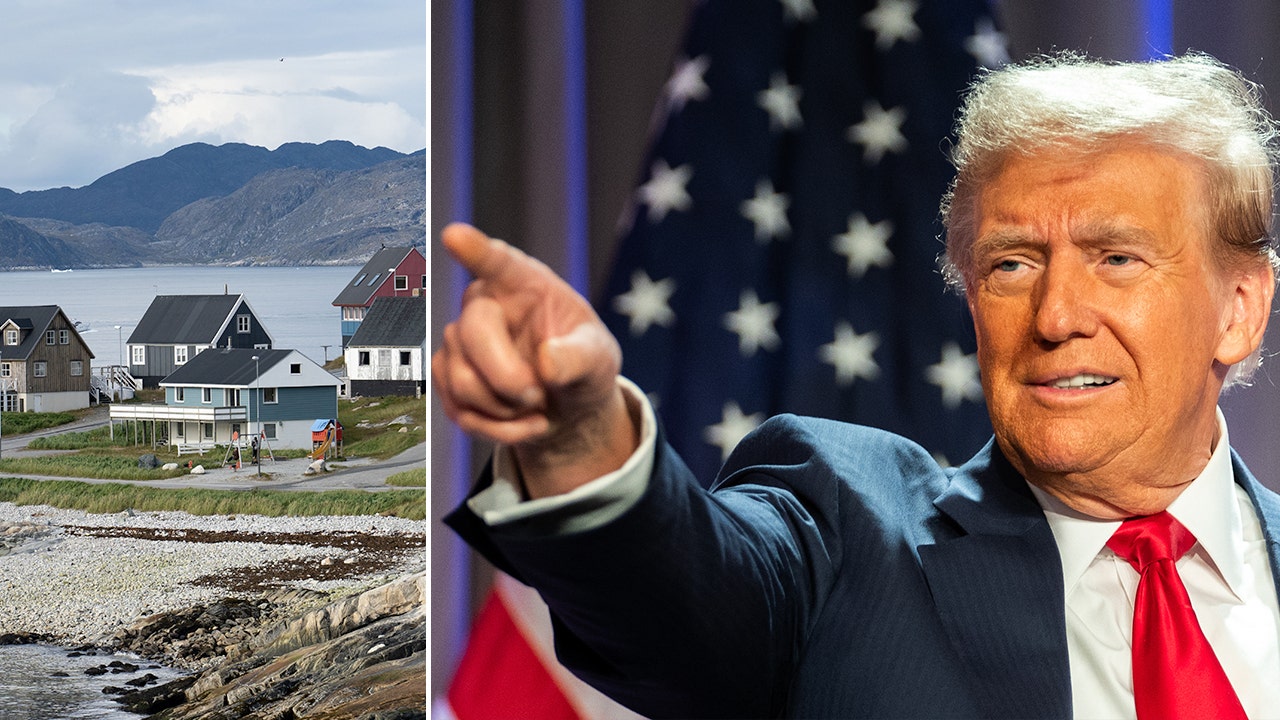Entertainment
Playing Martin Luther King Jr. and Malcolm X 'terrified' the stars of 'Genius: MLK/X'
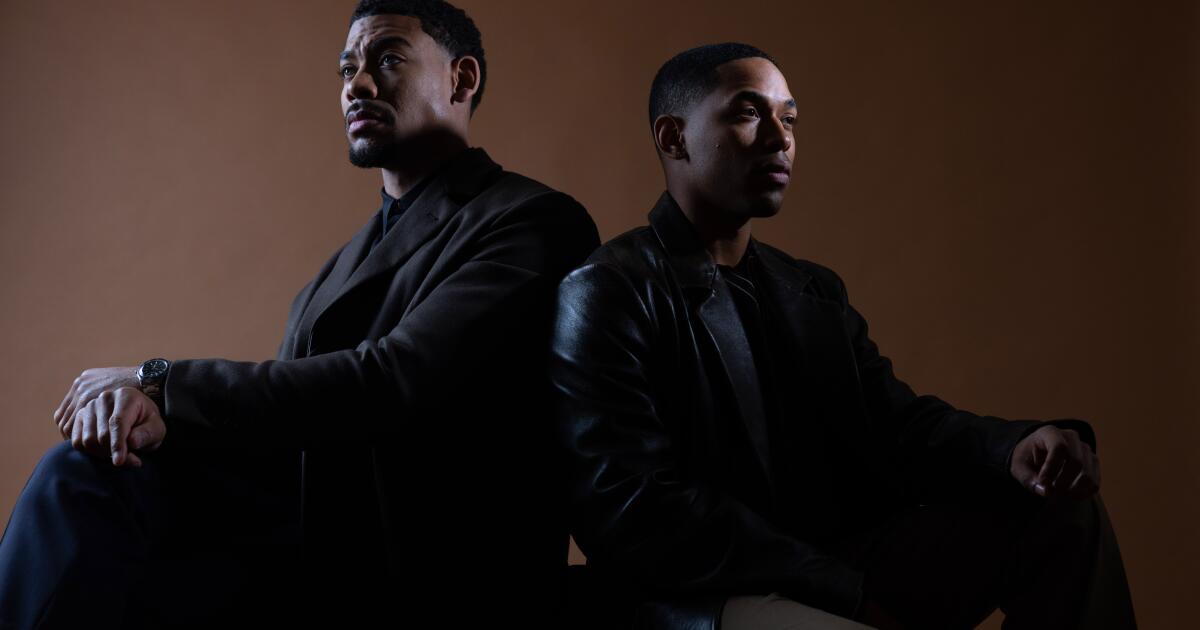
Kelvin Harrison Jr. and Aaron Pierre had the same reaction after learning that they had been hired to play the Rev. Martin Luther King Jr. and Malcolm X, respectively, in National Geographic‘s “Genius: MLK/X.”
Terror.
Not only did they both initially feel overwhelmed by the daunting responsibility of portraying the iconic civil rights leaders but they also felt their performances would likely be compared to those of others. Denzel Washington portrayed Malcolm X in the eponymous 1992 film that earned him an Oscar nomination, Samuel L. Jackson starred as King in Katori Hall’s Broadway production of “The Mountaintop” and James Earl Jones also portrayed King in the miniseries “Freedom to Speak.”
But with the support of friends and producers, Harrison and Pierre eventually overcame their doubts, delivering distinctive and bold portraits of the two men.
“MLK/X” is the fourth season of “Genius,” a biographical anthology series that has focused on Albert Einstein, Pablo Picasso and Aretha Franklin in previous installments. The final two episodes of the eight-part season, which premiered Feb. 1, run Thursday on National Geographic and stream the following day on Hulu and Disney+.
Co-starring as King’s wife, Coretta Scott King, is Weruche Opia (HBO’s “I May Destroy You”), and Jayme Lawson (“Till”) plays Betty Shabazz, the wife of Malcolm X. The executive producing team includes Gina Prince-Bythewood, Reggie Rock Bythewood, Brian Grazer and Ron Howard.
Harrison (“Chevalier”) and Pierre (“Foe”) knew each other — they are both involved in the upcoming “The Lion King” prequel, “The Lion King: Mufasa.” Pierre plays the title character, while Harrison plays the villain Scar.
Even though they share only a few scenes in “Genius,” they clearly became bonded during the project and expressed a palpable fondness for each other during a recent joint interview at a Pasadena hotel. Pierre occasionally patted Harrison’s knee during the discussion, calling him “my best friend.” This conversation has been edited for length and clarity.
1
2

1. Aaron Pierre plays Malcolm X. 2. Kelvin Harrison Jr. plays the Rev. Martin Luther King Jr. (Christina House / Los Angeles Times)
It must have been good news to be cast in this series, but I’m sure it was also scary.
Harrison: Initially, I was terrified. I didn’t know whether it was appropriate for me to be cast. I was 27, 28 years old, had just started acting and hadn’t lived that much life. I feel I have gotten the benefit of Dr. King’s and Malcolm’s work, but what was it that I could do to bring a further understanding of it? Then I thought, “I just have to get over myself.” The producers told me Dr. King was young when he began his journey. There was a lot of responsibility bestowed on him. Plus, he had a wife and kid. I felt a little naive, but that also fits in with the story we’re telling. It’s about taking on that naivety and not mistaking it for ignorance or a lack of intelligence. It’s also about not losing that sense of hope that we have in our country and our identities in who we are, putting one foot in front of the other and walking in faith. Then I got excited thinking, “I can’t believe I get to go on this journey.”
Pierre: I share that sentiment. I’m the same age as Kelvin. When I got the call, I questioned whether I had the capacity, the endurance, the durability, the emotional intelligence, the life experience. I didn’t say yes immediately because I needed to sit with that and understand what that feeling was and how I was going to channel those feelings into something that would propel me forward as opposed to prohibiting me. Once I thought I could do that, largely because of the support network about me personally and creatively, I knew I could begin embarking on the journey. You find joy in it, which is so important because what these men did needs to be celebrated and championed.
1

2

1. Aaron Pierre as Malcolm X in “Genius: MLK/X.” (Richard DuCree / National Geographic) 2. Kelvin Harrison Jr. as the Rev. Martin Luther King Jr. (Richard DuCree / National Geographic)
What was the research process like?
Pierre: We both watched and absorbed a tremendous amount of historical footage. I went to “The Autobiography of Malcolm X,” which is something I think I will revisit more than once in my lifetime. Then there’s “The Sword and the Shield: The Revolutionary Lives of Martin Luther King Jr. and Malcolm X,” which I trusted implicitly with its historical knowledge and insight. I visited Harlem, which fueled me in a very beautiful way.
Harrison: My initial instinct was to watch every movie about Dr. King, but my young actor brain and every actor I respected said, “Stay away from doing that.” So I refused that impulse. Then I had to figure out what those actors did. What I found out is that they brought a little bit of themselves to the role. I had to do an investigation of myself to figure out how to bring my humanity.
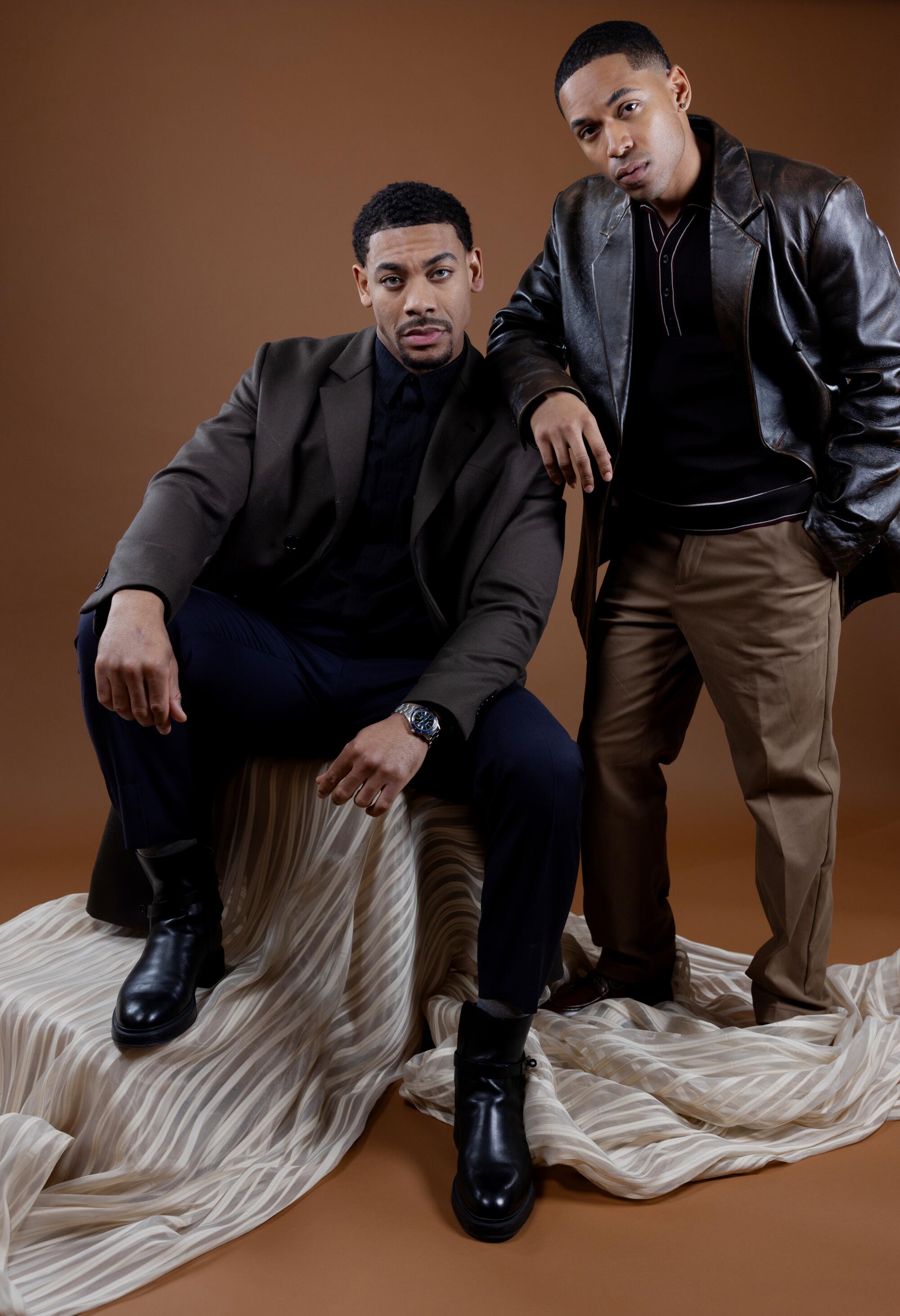
To prepare for their roles, Aaron Pierre, left, with Kelvin Harrison Jr., says they “both watched and absorbed a tremendous amount of historical footage.”
(Christina House / Los Angeles Times)
Aaron, were you intimidated by Denzel Washington’s acclaimed performance as Malcolm X in Spike Lee’s film?
Pierre: Denzel is a hero of mine. I have the utmost respect for him, not only artistically but personally. I had to manage that a hero of mine had played a hero of mine. I dealt with that by accepting that truth and then setting it free. Once I did that, I was able to permit myself to be liberated and safe enough to explore my own portrayal and bring my own life experience to Malcolm.
Kelvin, you had a similar situation. The actors who have played King include Jeffrey Wright and James Earl Jones.
Harrison: It’s kind of none of my business at a certain point. Dr. King was called to do something. If the people behind this project are calling me to do this, they see something in me I can’t see. And it’s arrogant for me to sit there and debate about it.
Pierre: At a certain point, we made peace with that fact, realizing all we can do is do our best. We use everything in our power to serve these tremendous men and their stories and legacies. Beyond that point, we have to set it free and let it be. It’s the only way to protect your well-being.
King and Malcolm X’s stories are told on parallel tracks. You share only a few scenes, but it’s clear you felt connected to each other.
Pierre: Absolutely. Aside from the professional work we share, this is one of my dearest friends. There’s a true sense of support and seeing one another through each others experience. We have so many parallels and similarities of our respective lives. We didn’t see each other a lot on set, but when we did, we checked in with each other. We understood that what we were embarking on was not easy. It required vulnerability.
Harrison: One of the times we did connect was when he came over to my little apartment in L.A. He brought doughnuts and I cooked. We talked about everything — how our journeys were going so far. Then we watched “Devil in a Blue Dress” with Denzel and Don Cheadle. We filled our cups with these beautiful portrayals. It was inspiration. It’s so easy to want to retreat when you’re on a journey like this. You get overwhelmed. You want to say, “This is too hard, I’m backing out.” So it’s important to have those moments to reconnect and say, “We’re in this together.”
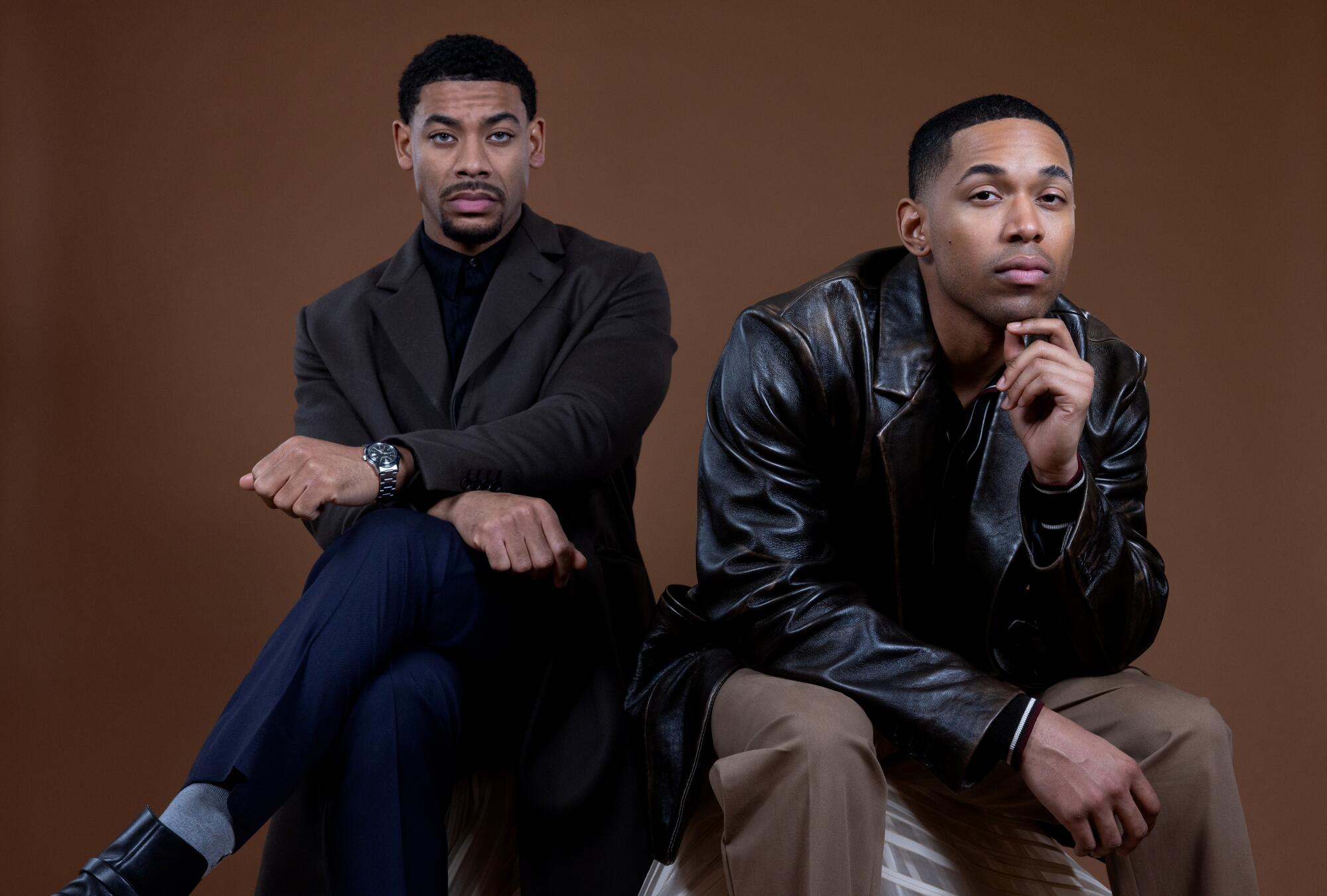
The actors say they tried to support each other in their roles. “We talked about everything — how our journeys were going so far,” says Kelvin Harrison Jr.
(Christina House / Los Angeles Times)
What was the most challenging day for you both?
Pierre: If we’re being honest, every day was challenging. This isn’t an engagement that ended with the final scene of the day. This demanded that we be engaged every day for the five or six months we did this. Every day we felt the weight of wearing those jackets.
Were you ever able to relax? What did you do to relieve stress?
Pierre: I’m really very grateful to Kelvin and Weruche. I have a tendency, no matter what the project is, but particularly with a project of this magnitude, to completely immerse myself for the duration. But they really looked after me. I would just be sitting in my trailer, in the suit with the glasses on, waiting for the next scene. Then one or both of them would drop by and say, “I brought you some shrimp.” They would bring joy. They contributed to the health of my personal well-being.
Harrison: I read somewhere that Martin’s favorite show was “Star Trek,” and he would watch that to decompress. So I thought, “I’ve got to find my own show.” So I got addicted to “Big Brother.” That was my “Star Trek.” I know that show is ridiculous, but I refuse to give it that label because it’s so good. It was like, “They’re stuck in this house. On the set, I’m stuck in this universe.” I related to them, and it would make me laugh and have fun.
What do you think audiences will learn from “Genius”?
Pierre: I hope it will dispel the myths and reveal the truth about the experiences of these men. There is a considerable amount of misinformation about Malcolm X. They need to gain the understanding that he operated from a place of love and light. Some might say he was advocating for physical engagement. I disagree. I think he was advocating for safeguarding and preserving the safety and livelihoods of your loved ones, your community and for those who look like you.
Harrison: Our job as storytellers is to inspire. With this story, I see it as a mirror to our country and the cyclical nature of it.

Movie Reviews
Movie Review: “Mufasa,” everything we didn’t need to know about “The Lion King”

The CGI animated savannahs, rivers and rock formations of Africa are photo-real, and the animals populating it have never been more realistically rendered than they are in “Mufasa: The Lion King.”
Disney felt the need to have the lions, warthog and meercat’s lips move when they sing, which is saying something.
But let’s keep this review short and not-exactly-sweet, unlike this boardroom-ordered prequel to one of Disney’s most popular intellectual properties. “Mufasa: The Lion King” never makes the case that it’s a story that needed to be told or a movie that needed to be made.
It’s about how Mufasa got separated from his birth-parents’ pride of lions, and joined another, becoming “brothers” with the lion cub who “saved” him, but who will come to be called “Scar.”
So the object of this prequel is to show how Mufasa became Lion King and how Scar got his scar and became the bitter rival in their pride.
The “story” is framed as a “story” Rafiki the ape (John Sani) tells Simba’s cub, and that cub’s protectors/babysitters, Timon (Billy Eichner) and Pumbaa (Seth Rogen).
The tale is of another coming-of-age quest, with two young-lions on their own this time, paired-up, depending on each other, on the run from a pride of albino lions led by the killer Kiros (Mads Mikkelsen).
There are new songs of a far more forgettable nature than those from the animated classic “The Lion King.”
“The circle is broken,” he growls, and we believe him.
There are harrowing moments of drama in their quest, but there’s precious little humor to the movie, all of it provided by the same duo who have always been the comic relief, Timon and Pumbaa.
“We’ve been singing ‘Hakuna Matata’ since forever!”
“Who hasn’t?“
The messaging, about taking in “strays,” and that “To be lost is to learn the way,” is weak tea.
Story failings aside, it’s not a bad movie. But “Mufasa” never lets us forget the limited-entertainment-value of the entire undertaking. Oscar winner Barry Jenkins (“Moonlight”) was hired to direct, but aside from a few voice casting decisions (Keith David, Anika Noni Rose, with Aaron Pierre and Kelvin Harrison, Jr. as Mufasa and Taka/Scar), he brings nothing to this that makes a difference.
Disney’s tech/animators telling their bosses that “Yes, we can make it look like a movie with real singing lions and bathing hippos on the veldt without using real animals or shooting on location” is no justification for showcasing that technology.
Story matters, and this one didn’t need to be told.

Rating: PG, some violence
Cast: The voices of Aaron Pierre, Kelvin Harrison, Jr., Tiffany Boone, John Kani, Mads Mikkelsen, Thandiwe Newton, Keith David, Billy Eichner and Seth Rogen.
Credits: Directed by Barry Jenkins, scripted by Jeff Nathanson, based on characters from Disney’s “The Lion King.” A Walt Disney release.
Running time: 1:58
Entertainment
Justin Baldoni's ex-publicist sues over alleged Blake Lively smear campaign

As Blake Lively’s allegations against her “It Ends With Us” director and co-star Justin Baldoni continue to reverberate through Hollywood, a new lawsuit has further raised the stakes.
Stephanie Jones, Baldoni’s former publicist, filed a complaint Tuesday in New York Supreme Court, accusing the actor’s crisis PR team of waging a coordinated effort to undermine her and deflect blame for what she calls a retaliatory smear campaign targeting Lively.
The new lawsuit adds to the mounting fallout from Lively’s legal complaint filed last week in California. In it, the actor accused Baldoni of sexually harassing her on the set of the romantic drama and orchestrating a campaign to discredit her after she raised concerns about a “hostile work environment.” Her complaint detailed allegations of “improvised physical intimacy” during scenes, pressure from Baldoni to perform greater nudity than originally agreed upon and a calculated effort to spread damaging stories about her in the press.
Jones alleges that Jennifer Abel, formerly a senior figure at her PR firm Jonesworks, collaborated with crisis manager Melissa Nathan on a “no-holds-barred strategy” to shield Baldoni from Lively’s misconduct allegations while simultaneously undermining Jones’ own reputation. According to her lawsuit, the plan involved planting negative stories about Lively in the media, creating fake social media accounts to amplify the attacks and leveraging Baldoni’s public image as a feminist ally to discredit her.
“Behind Jones’s back, [Abel and Nathan] secretly coordinated with Baldoni and [his studio] Wayfarer to implement an aggressive media smear campaign against Baldoni’s film co-star,” the lawsuit states.
Jones, who represented Baldoni and Wayfarer from 2017 until her termination in August 2024, claims the alleged scheme destroyed her professional relationship with the actor-director. Abel is accused of using confidential company information to poach clients and lay the groundwork for a competing PR firm.
“Defendants Abel and Nathan secretly conspired for months to publicly and privately attack Jones and [her PR firm] Jonesworks,” the lawsuit alleges, describing efforts to “steal clients and business prospects” while pinning the blame for the smear campaign on Jones herself.
The filing includes excerpts from thousands of pages of text messages and emails that Jones says were extracted from Abel’s company-issued phone after her firing from Jonesworks in August, shortly before the company’s relationship with Baldoni and Wayfarer came to an end. In one exchange, Abel allegedly described Baldoni as “pompous” and mocked his decision to attend a men’s retreat during the film’s release, writing, “He doesn’t need a retreat. He needs to be humbled.”
Jones accuses Abel and Nathan of weaponizing the controversy to “drive a wedge” between her and Baldoni, isolating her in the industry and damaging her career. Her lawsuit seeks damages and a court order to halt what she describes as ongoing harassment and professional sabotage. “This lawsuit seeks to finally put a stop to their continued misconduct and to compensate Jones and Jonesworks for the damage Defendants’ conduct and scheme has inflicted,” the filing reads.
Bryan Freedman, an attorney representing Baldoni and the other defendants, could not immediately be reached for comment but has previously dismissed Lively’s claims against his clients as “false, outrageous, and intentionally salacious.”
As lawsuits from both Lively and Jones unfold in the courts and the public eye, the controversy has cast a harsh spotlight on Hollywood’s PR playbook, exposing the darker corners of reputation management in an industry facing calls for greater transparency and accountability.
The allegations have already had professional repercussions for Baldoni. Earlier this week, his talent agency, WME, dropped him as a client and the nonprofit Vital Voices Global Partnership rescinded an award honoring him as an advocate for women’s empowerment. In a statement, the organization said Baldoni’s alleged “abhorrent conduct” detailed in Lively’s lawsuit was “contrary to the values of Vital Voices and the spirit of the Award.”
Author Colleen Hoover, whose bestselling novel “It Ends With Us” was based on, has also expressed support for Lively, writing on Instagram: “Blake’s ability to refuse to sit down and ‘be buried’ has been nothing short of inspiring.”
Movie Reviews
Better Man (2024) – Movie Review

Better Man, 2024.
Directed by Michael Gracey.
Starring Robbie Williams, Jonno Davies, Steve Pemberton, Damon Herriman, Raechelle Banno, Alison Steadman, Kate Mulvany, Frazer Hadfield, Tom Budge, Anthony Hayes, Jake Simmance, Jesse Hyde, Liam Head, Chase Vollenweider, Rose Flanagan, Jack Sherran, Karina Banno, Asmara Feik, Leo Harvey-Elledge, Elyssia Koulouris, Frazer Hadfield, Chris Gun, Ben Hall, Kaela Daffara, and Chase Vollenweider.
SYNOPSIS:
Follow Robbie Williams’ journey from childhood, to being the youngest member of chart-topping boyband Take That, through to his unparalleled achievements as a record-breaking solo artist – all the while confronting the challenges that stratospheric fame and success can bring.

During a conversation exploring the possibility of a biopic, British popstar Robbie Williams told well-regarded musical director Michael Gracey that he saw himself as a monkey performing for others. That became the window into telling the story of this singer/songwriter with Better Man, a film that, as the title implies, also shows that Robbie Williams is self-aware of his flaws, mistakes, and shortcomings without being afraid to put them front and center. Yes, rather than go through the arduous casting process, Michael Gracey ran with that comment literally, making the creative choice to have the pop star played by a CGI monkey (voiced by Jonno Davies, with Robbie Williams lending his vocals.)
It’s a smart move to roll a short clip of subject and filmmaker conversing before the film starts proper, not just because other parts of the world might not be familiar with Robbie Williamss music (consistently accidentally reading it as a biopic about musician Robin Williams if you’re anything like me), but also since this is such a bold concept for a biopic that it’s helpful to get an idea of what this man looks like and the personality he puts out there before it’s all monkey business.

Going one step further, this turns out to not fall into the trappings of a flailing gimmick but ties into themes of pressures of the music industry, fame causing stunted behavior, family drama, and an unflinching portrayal of self that doesn’t smooth over any rough edges. Better Man is an invigorating biopic; a shot of adrenaline to the most overplayed, clichéd genre. After this, no one should be allowed to make biopics (at least ones about musicians) unless they have an equally creative angle or some compelling X factor behind it. Simply put, this film puts most recent offerings from the genre to shame, especially the ones that get trotted out at the end of every year as familiar awards bait.
Even though the life trajectory and story beats aren’t anything new to anyone who has ever seen a biopic about a musician before, it gets to be told with boundless imagination, typically coming from several dazzling musical sequences. Not only are they dynamic in presentation (whether it be jubilantly unfolding across the streets of London or something more melancholy regarding fatherly abandonment), but they are sometimes highwire concepts themselves; Better Man has one of the most thrilling, fantastically clever, visually stunning, and exciting takes on battling one’s demons.

The characters (including Robbie’s family, friends, lover, hell, and even Oasis) don’t interact or react to Robbie Williams as a monkey. It’s a visual treat for us (this film would fall apart without the astonishingly expressive technical wizardry from Weta, who already have proven themselves as outstanding in this field when it comes to the recent Planet of the Apes movies) but another personal, self-deprecating, honest interpretation of how Robbie saw himself during these life stages. Initially, this feels like it will end up as a missed opportunity for further creativity or humor. One of the more surprising elements here is that the filmmakers (with Michael Gracey co-writing alongside Oliver Cole and Simon Gleeson) are playing this material straight and not going for laughs. That confidence pays off, allowing a maximalist, melodramatic side to come out with sincere, absorbing emotional heft.
That story follows a standard rise and fall structure, with Robbie Williams finding inspiration from his initially supportive singing father (Steve Pemberton), exhibiting a relatable drive to make his grandmother (Alison Steadman proud, getting his start in boy band Take That before his insecurities and worsening substance abuse and egocentric behavior gets him kicked out, stumbling into a rocky relationship with Nicole Appleton (Raechelle Banno), and then not only finding the courage to put some meaningful lyrics out into the world through a successful solo career but managing the anxieties that come with performing in front of humongous crowds while constantly struggling with drug addiction.

Some of those aspects feel glossed over and aren’t as explored as they possibly could have been (the film is already 135 minutes, but some of it is given a broad strokes treatment), but it’s affecting anyway due to the creativity, artistry, musical numbers, and blunt honesty enhancing those character dynamics. Better Man is a biopic that starts with a confessional about being a narcissist and having a punchable face and ends up somewhere beautifully moving that perfectly captures the essence of that title. There is also a healthy dose of Frank Sinatra here, given that he was a major source of inspiration for Robbie Williams, so let’s say he and Michael Gracey did this biopic their way, and the result is something no one should want any other way.
Flickering Myth Rating – Film: ★ ★ ★ ★ / Movie: ★ ★ ★ ★
Robert Kojder is a member of the Chicago Film Critics Association and the Critics Choice Association. He is also the Flickering Myth Reviews Editor. Check here for new reviews, follow my Twitter or Letterboxd, or email me at MetalGearSolid719@gmail.com
https://www.youtube.com/watch?v=embed/playlist
-
/cdn.vox-cdn.com/uploads/chorus_asset/file/24924653/236780_Google_AntiTrust_Trial_Custom_Art_CVirginia__0003_1.png)
/cdn.vox-cdn.com/uploads/chorus_asset/file/24924653/236780_Google_AntiTrust_Trial_Custom_Art_CVirginia__0003_1.png) Technology6 days ago
Technology6 days agoGoogle’s counteroffer to the government trying to break it up is unbundling Android apps
-

 News7 days ago
News7 days agoNovo Nordisk shares tumble as weight-loss drug trial data disappoints
-

 Politics7 days ago
Politics7 days agoIllegal immigrant sexually abused child in the U.S. after being removed from the country five times
-

 Entertainment1 week ago
Entertainment1 week ago'It's a little holiday gift': Inside the Weeknd's free Santa Monica show for his biggest fans
-

 Lifestyle7 days ago
Lifestyle7 days agoThink you can't dance? Get up and try these tips in our comic. We dare you!
-
/cdn.vox-cdn.com/uploads/chorus_asset/file/25672934/Metaphor_Key_Art_Horizontal.png)
/cdn.vox-cdn.com/uploads/chorus_asset/file/25672934/Metaphor_Key_Art_Horizontal.png) Technology2 days ago
Technology2 days agoThere’s a reason Metaphor: ReFantanzio’s battle music sounds as cool as it does
-

 Technology1 week ago
Technology1 week agoFox News AI Newsletter: OpenAI responds to Elon Musk's lawsuit
-

 News3 days ago
News3 days agoFrance’s new premier selects Eric Lombard as finance minister


